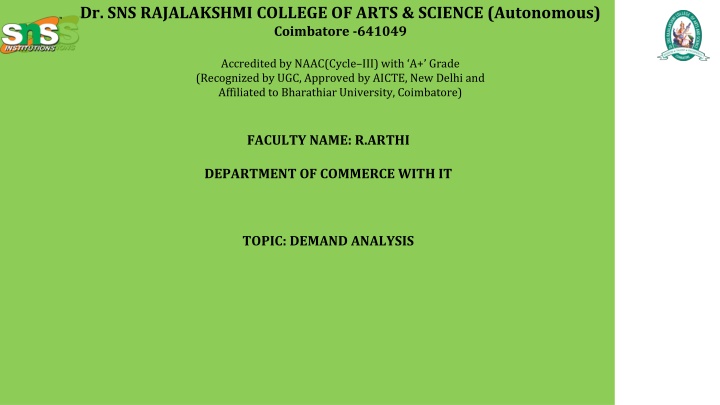
Demand Analysis and Types of Demand in Commerce
Explore the concept of demand analysis and various types of demand such as price demand, cross demand, income demand, joint demand, composite demand, derived demand, and direct demand in commerce.
Download Presentation

Please find below an Image/Link to download the presentation.
The content on the website is provided AS IS for your information and personal use only. It may not be sold, licensed, or shared on other websites without obtaining consent from the author. If you encounter any issues during the download, it is possible that the publisher has removed the file from their server.
You are allowed to download the files provided on this website for personal or commercial use, subject to the condition that they are used lawfully. All files are the property of their respective owners.
The content on the website is provided AS IS for your information and personal use only. It may not be sold, licensed, or shared on other websites without obtaining consent from the author.
E N D
Presentation Transcript
Dr. SNS RAJALAKSHMI COLLEGE OF ARTS & SCIENCE (Autonomous) Coimbatore -641049 Accredited by NAAC(Cycle III) with A+ Grade (Recognized by UGC, Approved by AICTE, New Delhi and Affiliated to Bharathiar University, Coimbatore) FACULTY NAME: R.ARTHI DEPARTMENT OF COMMERCE WITH IT TOPIC: DEMAND ANALYSIS
DEMAND ANALYSIS Desire is just a wish on the part of the consumer to possess a commodity. If the desire to possess a commodity is backed by the purchasing power and the consumer is also willing to buy that commodity, it becomes want. The demand, on the other hand is the wish of the consumer to get a definite quantity of a commodity at a given price in the market backed by a sufficient purchasing power. There are three important points to remember about the quantity demanded: First, the quantity demanded is the quantity desired to be purchased. It is the desired purchase. The quantity actually bought is referred to as actual purchase. Secondly, quantity demanded is always considered as a flow measured over a period of time, like if the quantity demanded of oranges is 10, it must be per day or per week, etc. Thirdly, the quantity demanded will have an economic meaning only at a given price. For example, the demand for oranges equal to 10 units per week at a price of Rs. 100 per dozen is a full and meaningful statement, as used in micro-economic theory.
TYPES OF DEMAND 1. Price Demand: Assuming other factors as constant, a relationship between the price and demand of a commodity is known as Price Demand. Price Demand can be shown as: Dx= f(Px) Where, Dx= Demand for the given Commodity f = Functional Relationship Px= Price of the given Commodity 2. Cross Demand: Assuming other things remaining as constant, a relationship between the demand of a given commodity and the price of related commodities is known as Cross Demand.
TYPES OF DEMAND TYPES OF DEMAND 3. Income Demand: Assuming other factors as constant, a relationship between the consumer s income and the quantity demanded for a commodity is known as Income Demand. Income Demand can be shown as: Dx= f(Y) Where, Dx= Demand for the given Commodity f = Functional Relationship Y = Income of the Consumer 4. Joint Demand: When demand for two or more goods arises simultaneously for satisfying a particular want of the consumer, then such type of demand is known as Joint Demand. For example, the demand for milk, coffee beans, and sugar is a joint demand as all these goods are demanded together to prepare coffee.
TYPES OF DEMAND TYPES OF DEMAND 5. Composite Demand: When a commodity can be used for more than one purpose, then such type of demand is known as Composite Demand. For example, the demand for water is a composite demand as it can be used for various purposes like bathing, drinking, cooking, etc. 6. Derived Demand: The kind of demand for a commodity, which depends on the demand for other goods, is known as Derived Demand. For example, demand for workers/labour, producing bags is a derived demand as it depends on the demand for bags. 7. Direct Demand: When a commodity directly satisfies the demand of consumers, then its demand is known as Direct Demand. For example, demand for books, stationery, clothes, food, etc., is a direct demand as these goods directly satisfy the wants.
TYPES OF DEMAND TYPES OF DEMAND 8. Competitive Demand: When two commodities are close substitutes of each other and an increase in the demand for one commodity will decrease the demand for the other commodity, then the demand for any one of the commodities is known as Competitive Demand. For example, an increase in demand for tea might decrease the demand for coffee, which makes the demand for these goods competitive demand. This happens because when consumers purchase more of one commodity (say tea), it leads to a lesser requirement for the other commodity (say coffee). 9. Alternative Demand: Demand for a commodity is known as alternative demand when it can be satisfied by using different alternatives. For example, there are number of alternatives to satisfy the demand for clothes like jeans, shirts, trousers, suits, saree, pants, etc.
